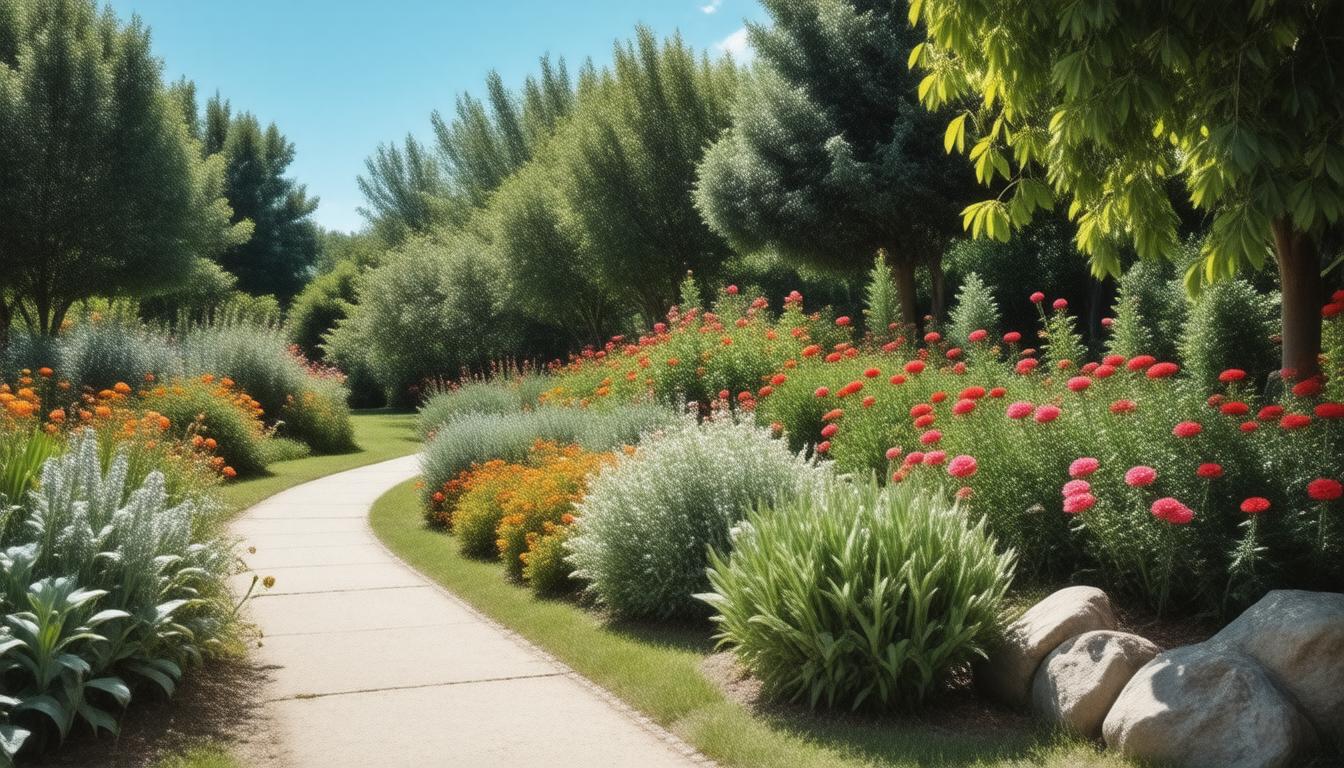Creating a stunning outdoor space can transform your home into an inviting oasis, but the process can seem daunting to many. That’s where The Ultimate Outdoor Plant Guide: Tips for Lush Landscaping comes into play. Whether you’re a seasoned gardener or just beginning your landscaping journey, this guide will walk you through essential elements to consider, ensuring your garden flourishes. From understanding your unique climate and choosing the right plants to the tools needed and maintenance tips, you’ll find everything you need here to achieve the outdoor beauty of your dreams.
Key Takeaways
- Know your local climate and soil type to select the best plants.
- Choose plants that thrive in your specific garden space for optimal growth.
- Invest in essential gardening tools to simplify the planting process.
- Implement effective watering and nutrient strategies for healthy plants.
- Adhere to landscaping design principles to enhance the visual appeal of your outdoor area.
1. Understanding Your Climate and Soil Conditions
When embarking on your landscaping journey, the first step in The Ultimate Outdoor Plant Guide: Tips for Lush Landscaping is to understand your local climate and soil conditions. Every plant has specific requirements regarding temperature, sunlight, and moisture levels, which means that recognizing the climate zone in which you live is crucial. Factors such as whether you are located in a warm, temperate region or a cooler, more arid area will significantly influence your plant choices. Additionally, conducting a soil test can provide insights into pH levels, nutrient content, and soil texture, allowing you to choose plants that thrive in your environment. By tailoring your plant selections to suit your local conditions, you ensure a vibrant, healthy landscape that not only looks stunning but also flourishes year-round.
2. Choosing the Right Plants for Your Space
When embarking on a garden transformation or enhancing your outdoor space, it’s crucial to understand that the right plants can elevate your landscape beyond mere aesthetics. In ‘The Ultimate Outdoor Plant Guide: Tips for Lush Landscaping,’ we emphasize the importance of selecting the appropriate flora tailored to your environment. Consider factors such as climate, sunlight exposure, and soil type in your choices. Native plants are not only easier to maintain but also support local wildlife, making them an excellent option for a thriving ecosystem in your garden. Additionally, incorporating a mix of perennials and annuals can ensure blooms from spring through fall, while strategic placement can create stunning focal points. With thoughtful selection and planning, your outdoor space will flourish beautifully, showcasing the vibrancy of nature right in your own yard.
‘To plant a garden is to believe in tomorrow.’ – Audrey Hepburn
3. Essential Tools and Equipment for Planting
When you embark on a gardening adventure, having the right tools and equipment is crucial for achieving the best results in your outdoor landscaping projects. In our Ultimate Outdoor Plant Guide: Tips for Lush Landscaping, we will discuss the essential tools that every gardener should consider. First on the list is a sturdy spade, necessary for digging holes and turning soil—essential steps in preparing your planting beds. A high-quality hand trowel is another must-have, perfect for transplanting seedlings and working in tight spaces. Don’t forget a pair of gardening gloves to protect your hands while giving you a secure grip on tools. Additionally, a reliable watering can or a hose with a spray nozzle ensures your plants receive the proper hydration they need to thrive. Lastly, a soil test kit can help you understand your soil’s composition, allowing for amendments that will give your plants the best chance to flourish. By equipping yourself with these essential tools, you set the stage for lush, thriving landscapes that enhance the beauty of your outdoor space.
4. Watering and Nutrient Management
Proper watering and nutrient management are pivotal components in achieving the lush, vibrant landscaping you desire, as outlined in ‘The Ultimate Outdoor Plant Guide: Tips for Lush Landscaping.’ Understanding the specific water needs of your plants is crucial; some species thrive with minimal hydration while others require frequent watering to flourish. It’s essential to assess soil moisture regularly and make adjustments based on weather conditions, particularly during hot seasons. Additionally, enriching the soil with organic fertilizers can significantly boost plant health and enhance growth. By incorporating a balanced feeding schedule and mindful watering practices, you can cultivate a thriving outdoor space that embodies the very essence of lush landscaping.
5. Landscaping Design Principles for Aesthetics
When it comes to creating a beautiful outdoor space, understanding the essential landscaping design principles is crucial for achieving the desired aesthetic. The Ultimate Outdoor Plant Guide: Tips for Lush Landscaping highlights five key principles that can transform your garden from ordinary to extraordinary. First, consider balance; incorporating a mix of plant sizes and types ensures a harmonious look that draws the eye without overwhelming the senses. Next, pay attention to color and texture, pairing vibrant flowers with varied foliage to create a dynamic visual appeal. Repetition is another critical element; repeating specific plants or colors can tie different areas of your landscape together and provide cohesion. Additionally, don’t overlook the importance of scale and proportion; choosing plants that complement the size of your space will enhance visual impact. Lastly, embrace variety while maintaining unity—diversify your plant selection to foster interest, yet stick to a cohesive theme to keep your landscaping looking polished. By applying these landscaping design principles, you can create a stunning outdoor environment that showcases lush, thriving plants and elevates your home’s curb appeal.
6. Maintenance Tips for Long-lasting Outdoor Beauty
Maintaining a beautiful outdoor landscape requires attention to detail and knowledge of your plants’ needs. In this section of
The Ultimate Outdoor Plant Guide: Tips for Lush Landscaping, we will explore essential maintenance tips to ensure your garden thrives throughout the seasons. Regular watering is crucial; deep watering encourages root growth rather than superficial sprouting. Additionally, mulching is a game changer as it not only conserves moisture but also suppresses weeds. Pruning dead or overgrown branches promotes healthier plants and enhances your garden’s aesthetic appeal. Don’t forget about fertilization; using a balanced fertilizer twice a year can revitalize your soil, allowing for robust plant growth. Lastly, pay attention to pest management by regularly inspecting your plants and using organic methods to deter unwanted insects. Following these maintenance tips will not only prolong the beauty of your outdoor space but also contribute to an inviting environment that you can enjoy year-round.
Frequently Asked Questions
What factors should I consider when understanding my climate and soil conditions?
You should consider your local climate zone, average temperatures, seasonal rainfall, and the type of soil you have (sandy, clay, loamy, etc.). Conducting a soil test can help determine pH and nutrient levels, which are essential for plant growth.
How do I choose the right plants for my outdoor space?
Select plants according to their growth requirements, such as sunlight, water needs, and hardiness zone. Consider the size of your space and how plants will complement or enhance each other in terms of color, shape, and texture.
What essential tools and equipment do I need for outdoor planting?
Basic tools include a spade, trowel, pruners, garden gloves, a watering can or hose, and a rake. For larger projects, consider a wheelbarrow, shovel, and tiller. Quality tools can make the planting process much easier.
How can I manage watering and nutrients efficiently?
Establish a regular watering schedule, paying attention to your plants’ specific needs, especially in hot weather. Use mulch to retain moisture and reduce weeds. Regularly fertilize plants according to their requirements, opting for slow-release fertilizers or compost.
What maintenance tips can help ensure long-lasting outdoor beauty?
Regularly check for weeds, pests, and diseases. Prune plants as needed to encourage growth and shape. Be sure to deadhead flowers, apply mulch, and adjust your watering and fertilizing schedules based on seasonal changes.




